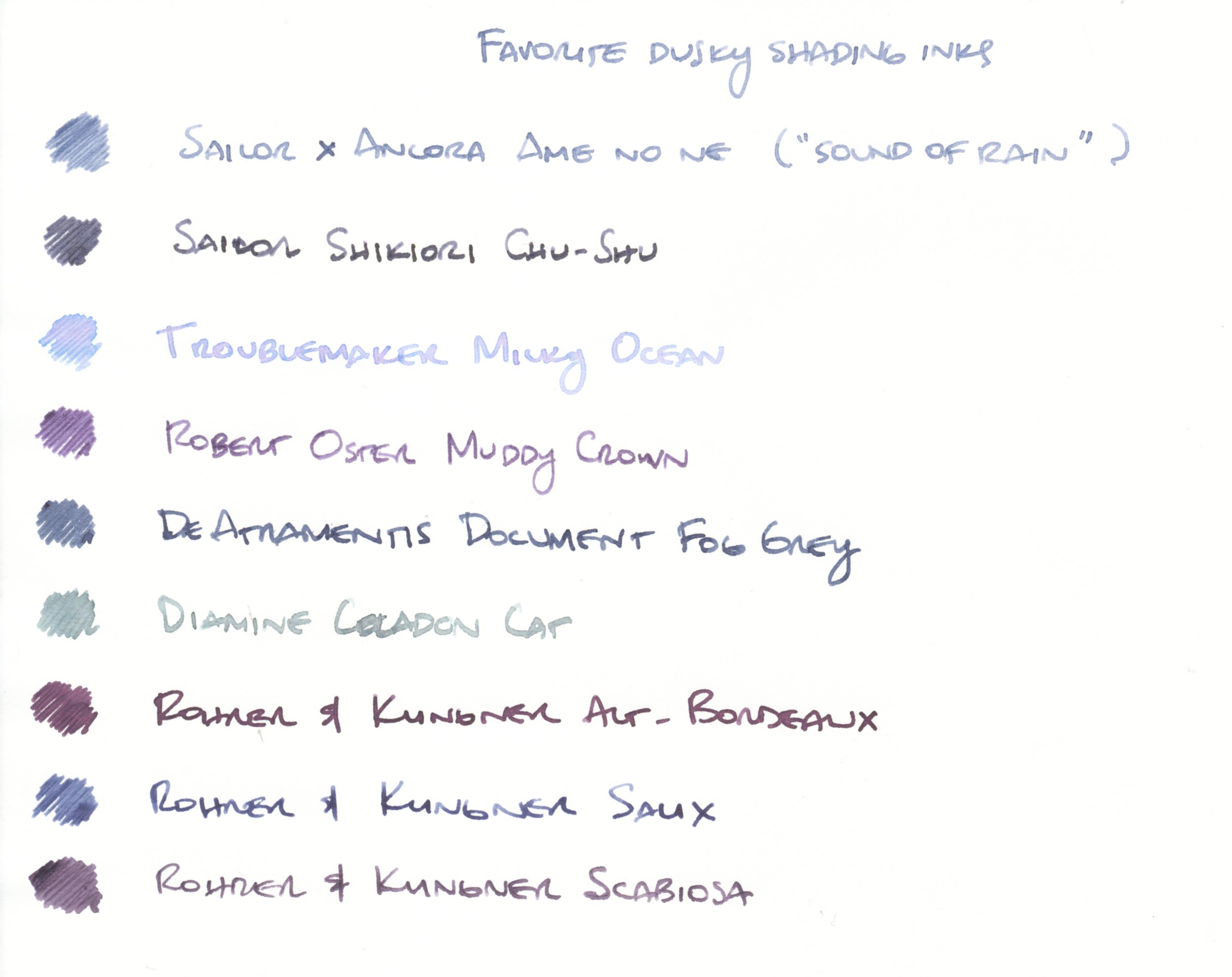Keeping an open mind with fountain pens
TL, DR: I had a lot of strong opinions and questions about fountain pen trends that have evolved over time, sometimes surprising me, given my initial, knee-jerk reactions. It's nice to keep an open mind in many situations. ✌️
Before I got fully into collecting fountain pens, I was a big gel pen user (I still use them, but not as often), preferring 0.38-0.5mm line widths. I also really liked using Sakura Pigma Micron, and Staedtler Triplus Fineliner pens. I thought that, of course, I would only like extra fine or fine fountain pen nibs, as a result.
My first fountain pen purchases -- Kaweco Sport and Kaweco AL Sport -- had fine nibs, which seemed like all I would want or need. I could not understand why someone would want a broader nib (my handwriting is small, too, for additional context). But of course, as I tried different inks, particularly shimmer inks, I learned that the best nibs to see shimmer and other characteristics like shading and sheen, are broader and wetter nibs. (I also didn't understand why some people would extol the virtues of a “juicy”, wet nib, as I wanted my writing to dry as quickly as possible at first.)
Thus began my journey of learning to get past my gut reactions to various fountain pen trends or concepts (in no particular order):
Why so expensive?
I think a normal reaction for newbies to fountain pens is to wonder why some brands or some specific pens are so expensive. The Montblanc 149 Meisterstuck, Visconti Homo Sapiens Lava Bronze, Namiki urushi pens that are a solid color with no maki-e or raden accents (especially a "boring" black one), and the black Lamy 2000 all are iconic pens that a lot of people celebrate, and even covet as "grail pens". My initial reaction to all of them was, "Why? They seem so boring looking." Keep in mind, my personal taste for fountain pen design would be considered flamboyant compared to these pens. I generally love brightly colored fountain pens with glitter, shimmer, and other eye-catching designs.
My most ostentatious fountain pens
However, as I learned more about the history behind these pens and brands, I started to understand that they use high-end materials, have top-notch (often made of gold) nibs, and in the case of urushi, no matter the simplicity or complexity of the design, the amount of work put into these pens by skilled artisans clearly explains why the pens are works of art that command high prices.
Image from The Nibsmith, the Namiki Yukari Royale Maki-e fountain pen in the peony design, one of my grail pens
This looks like a simple pen, but knowing how long it takes an artist to complete one can give a different perspective (though if I bought this pen, I’d at least splash out for a red one!)
Even if I may never buy a Visconti Homo Sapiens lava pen, I understand that it uses a unique material that probably costs a lot to make, and provides a different experience than a regular resin or metal pen, making that experience worth a higher price to collectors. Additionally, some brands are smaller manufacturers who can't achieve lower prices through higher volume of sales. Of course, there's always going to be a level of brand hype that can overinflate prices for sought-after items, but I learned that if a fountain pen is expensive, there may be additional valid reasons behind the high cost.
Why big fountain pens?
I also had a knee-jerk reaction to big fountain pens, not understanding why anyone likes oversized pens. As a person with small hands who prefers lighter fountain pens, I could not fully relate to someone like David Parker from Figboot on Pens who has stated that he prefers larger pens with thicker grip sections. These pens would look comically oversized in my small hands. 😅
Firstly, people with bigger hands would obviously feel more comfortable using larger pens to match their physicality. I’ve also seen many people mention that pens with larger grip sections feel more comfortable because they have some difficulty in maintaining their grip on narrower pen bodies over a long period of time. People with bigger handwriting might also feel more at ease using a larger pen.
Big fountain pens allow for a broader canvas to show off the artistic design of a pen. If you had a stunning urushi or maki-e pen, you'd probably appreciate a larger pen so you can see the intricate details more clearly, and have more art to look at and enjoy. Pens using unique materials like custom resins or machined metal would also look more impressive in a larger pen body. Larger pens with #8 sized nibs can look grand compared to “regular” smaller pens simply because they’re not as common. I admit they are attention-grabbing.
Tangential story of how I sort of became okay with bigger fountain pens: I watched a video from the Pens and Tea YouTube channel about the Jinhao X159, the latest pen from Jinhao that has a #8 (large!) nib. It was titled, "This is the MOST important pen you'll ever buy!" which, of course, caught my attention. The creator made the argument (in a somewhat over-the-top manner, starting with the video title) that the X159 can help you affordably determine whether you would like a larger pen like the Montblanc 149, which is what the Jinhao is paying homage to, putting it nicely.
Of course the Jinhao doesn't have the same feel, quality materials, or performance, but its pen body and nib size can give you a good idea of how you might react to "the real thing". Since I'd been seeing other posts online and videos about how people liked the X159 at the time, I was swayed into buying one. While my initial reaction was, "ugh, this pen is ridiculously huge," I kept using it and eventually started to like it. It helped that it's a light pen, and for a fine nib, was a wet writer that ended up closer to a medium nib in performance. Besides my 2 BENU Euphorias, my Jinhao X159s are the largest pens in my collection so far. It's a good knock-around, daily driver pen that you won't be sad about if something happens to it (and is cheap to replace, should you want to). Anyway, the Jinhao is the first larger pen I grew to appreciate.
On the left, smaller and/or narrower fountain pens I started out using, and on the left, larger, thicker fountain pens whose larger form-factors I’ve grown to appreciate (it helps that they’re light)
Why shading/sheening/shimmering inks?
I started out with very basic fountain pen inks, getting a couple different colors of Kaweco cartridges in Midnight Blue and Summer Purple. My first bottled inks I bought when I wanted to try converters were Diamine Red Dragon and Sailor Shikiori Chu-Shu. I then tried lots of ink samples and bought more bottles of ink, as one does. Some time later I discovered shimmer inks and thought that I would only ever write with shimmer inks going forward. I was endlessly fascinated and delighted by the colors and how awesome the shimmer looked on my journal pages. When I swatched inks daily from my Diamine Inkvent calendar last December, I remember being disappointed when an ink wasn't a shimmer ink.
Then weirdly, almost in a 180-degree flip, a month or two (or more) ago, I started preferring dusky shading inks and deprioritized using shimmer inks. I didn't swear off shimmer inks entirely, but I wasn't using them as extensively as I was before. Of course, this is entirely a question of taste. There's no right or wrong answer, and most people's tastes will evolve over time. It just really surprised me when I was so enthusiastically into shimmers and resisting using any "regular" inks, and :snap: just like that decided that I was going to write mainly with dusky shading inks instead.
My current favorite dusky, shading inks: Sailor x Ancora Ame no ne (“sound of rain”), Sailor Shikiori Chu-Shu, Troublemaker Milky Ocean (somehow looking less dusky in this sample), Robert Oster Muddy Crown, DeAtramentis Document Fog Grey, Diamine Celadon Cat, Rohrer & Klingner Alt-Bordeaux, Rohrer & Klingner Salix, and Rohrer & Klingner Scabiosa
I have always liked the shading property of certain inks. I think one of the first inks that really stood out to me for its shading was Herbin Ambre de Bermanie, a lovely caramel, yellow-brown. I know there are some out there who don't prefer the inconsistent look of shading inks. I can find it kind of distracting when the base ink color is too light compared to its shading color, which makes it seem like the pen is just not working properly.
I have seen sheening inks and have not yet been that interested in them, partially because of how much longer it seems they need to dry (and some seem like they never fully dry :O). But there are some interesting ones out there, like Birmingham Pen Company's Emerald Fusion, which is a deep emerald green with a strong metallic-looking green sheen.
Somewhat hard to see in this swatch but Emerald Fusion has a metallic green sheen
Perhaps I will look into them more later, but I'll probably explore dual-shading and color-changing inks like those from Sailor first.
And in conclusion… (heh)
I'm sure there are plenty of other fountain pen-related opinions or preferences I had early on in my explorations that have changed as my knowledge about different aspects of using and collecting fountain pens has grown. I keep surprising myself with the changes in preferences or perspectives I have, which is a fun aspect of the hobby.
Let me know what fountain pen-related opinions you once held and have changed. Should be an interesting conversation. 🙂






